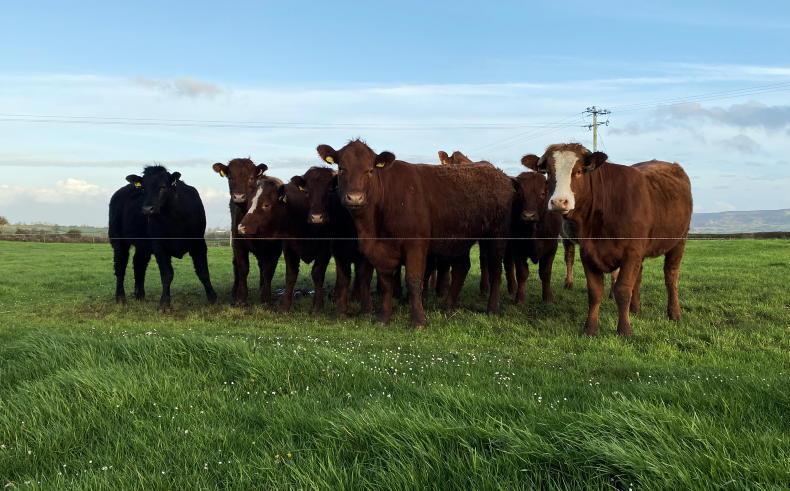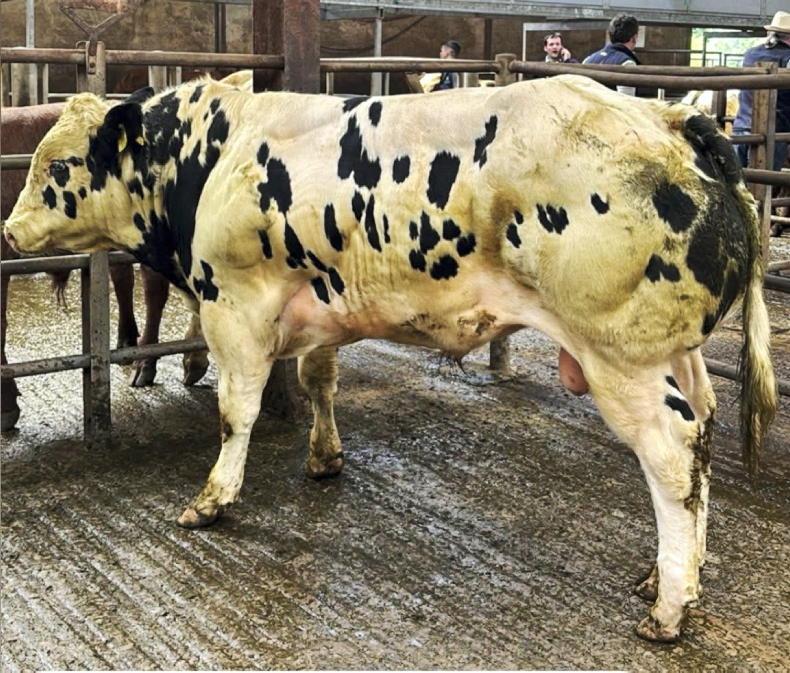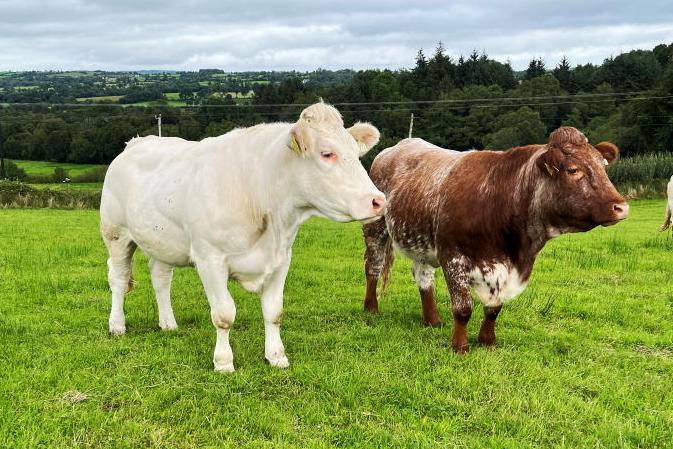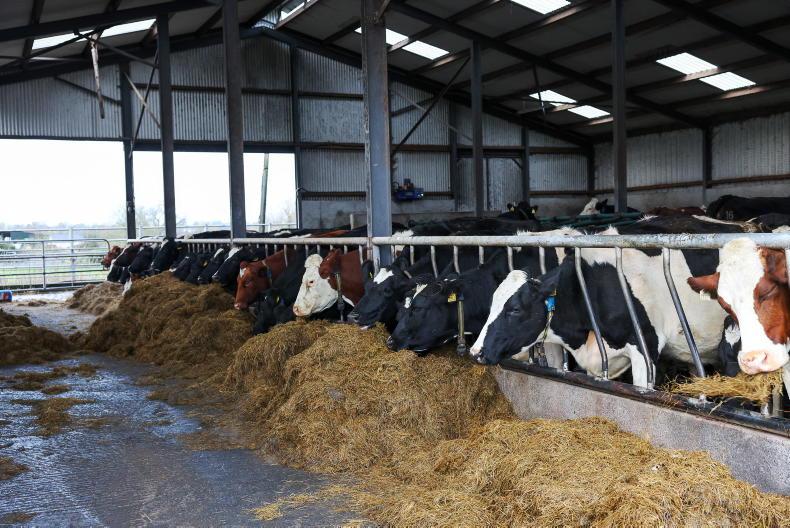Trevor Boland is well known in the south Sligo area, not just as a suckler farmer who is part of the Future Beef programme with Teagasc, but also as an accountant with ifac, serving local farmers financial needs. With a herd of 50 autumn calving cows, Trevor has been chasing milk and fertility for a number o years, with the next breeding aim being to increase carcase weight through sire selection.
Calving and breeding
All cows are calved in the autumn over a short time period, with the majority calving compactly in August and September. Trevor chooses autumn over spring for a number of reasons.
"I wouldn’t have the facilities in the yard to calve down 50 cows in the spring. All calving is done outdoors in the autumn which really helps to cut down labour. Working off farm with a fragmented farm, autumn calving also allows me breed all of the herd to AI.’’
Breeding goals
A high degree of Salers semen has been used throughout the years for breeding replacements, with the result being most cows having a Salers genetics in them. Teagasc beef specialist Aidan Murray highlighted that a stigma surrounding docility with Salers though they can be "very fertile, great milkers and a good ability to calve, but may not be everyone’s cup of tea in what they see as their ideal suckler cow.’’
Trevor’s herd is showing the focus on daughter milk throughout years of selective breeding, with the herd ranking five stars with an index value of €135 and a daughter milk index of +6.6kgs.
Despite the stigma with temperament and Salers, the herd still ranks three stars. Where Trevor would now like to hone in on is improving carcase weight, which currently sits at +16kgs. "I feel I have enough milk in the herd now, and while I don’t want to lose milk, I want to increase the herd’s carcase weight."

In-calf heifers grazing on the Skreen outfarm. The nature of the farm is very dry, with heifers and heifer weanlings grazing for a number of weeks now.
"There’s been a lot of talk over the last few months over changes to the ICBF index, over changes to economic evaluations and a carbon cost within the system, be it right or wrong. The herd, in terms of where Trevor is at the minute, he’s sitting at €135, with the national average being €98, he’s in the top 10%. There’s enough milk in the system there to drive on,’’ stated Murray.
Trevor is producing bulls for selling at 10-11 months, with heifers either retained for breeding, sold to other herds for breeding or slaughtered. Sexed semen will hopefully be used this year on Trevor’s top 20 cows, with the remainder receiving a terminal Charolais or Limousin. Lapon (CH4321), Drulines S (LM9577) and Pottlereagh Mark (CH4160) have all been selected as possible terminal sires to use this autumn.
Weaning weight percentage
While cow type consists of good framed Salers-crosses which are by no means a small cow, Trevor is still exceeding his weaning efficiency targets with a target weaning percentage of 42%.
This is an impressive feat considering a) the majority of milk coming off the cows is off silage fed indoors and b) no concentrates are fed to cows. "The cows don’t know what meal is. Even the first calved heifers receive zero meal. What I would do is pen those first calved heifers together to avoid any bullying.’’
Currently, nearly all calves are weaned and at grass, with weaning having commenced in February. Regarding the debate on turning autumn calving cows out to grass in spring time, Aidan Murray said "we had done a trial with a farmer who was in the better farm programme a number of years ago, where half the calves were left on the cows when turning out to grass. The calves that had been weaned before going to grass actually weighed heavier in the next weighing.’’
Quality silage
With the difficult spring, silage stores for next year was one of the focuses of the walk. Local adviser Cian Devanney spoke on how a delay in cutting could drastically effect silage quality. "What we are encouraging farmers to do is aim for that earlier cut. Slurry should not be spread on silage ground this time of the year; hold it off for second cut. A mid-May cut will allow for a high quality first cut and will allow covers to green up quickly again with good growth in May. "With silage ground not grazed in many areas, Devanney stated that dead butt due to old growth could be compensated by targeting an earlier cut of silage.
With Trevor, calved cows will require 75+DMD silage to support milk and growth, especially in first calved heifers. All silage is made in bales, allowing for a greater degree of flexibility. Planning is key to making silage in Trevor’s eyes. "If you are thinking of cutting soon, talk to your contractor and let them know you will be ready the next weather window. It’s no use ringing them at 10am and expecting them at 3pm.’’
Farm facts
Location: Dromard/ Skreen Co Sligo
Farm size: 50 ha (fragmented)
Herd Size: 50 autumn calving cows + followers
Herd Eurostar rating: €138
Trevor Boland is well known in the south Sligo area, not just as a suckler farmer who is part of the Future Beef programme with Teagasc, but also as an accountant with ifac, serving local farmers financial needs. With a herd of 50 autumn calving cows, Trevor has been chasing milk and fertility for a number o years, with the next breeding aim being to increase carcase weight through sire selection.
Calving and breeding
All cows are calved in the autumn over a short time period, with the majority calving compactly in August and September. Trevor chooses autumn over spring for a number of reasons.
"I wouldn’t have the facilities in the yard to calve down 50 cows in the spring. All calving is done outdoors in the autumn which really helps to cut down labour. Working off farm with a fragmented farm, autumn calving also allows me breed all of the herd to AI.’’
Breeding goals
A high degree of Salers semen has been used throughout the years for breeding replacements, with the result being most cows having a Salers genetics in them. Teagasc beef specialist Aidan Murray highlighted that a stigma surrounding docility with Salers though they can be "very fertile, great milkers and a good ability to calve, but may not be everyone’s cup of tea in what they see as their ideal suckler cow.’’
Trevor’s herd is showing the focus on daughter milk throughout years of selective breeding, with the herd ranking five stars with an index value of €135 and a daughter milk index of +6.6kgs.
Despite the stigma with temperament and Salers, the herd still ranks three stars. Where Trevor would now like to hone in on is improving carcase weight, which currently sits at +16kgs. "I feel I have enough milk in the herd now, and while I don’t want to lose milk, I want to increase the herd’s carcase weight."

In-calf heifers grazing on the Skreen outfarm. The nature of the farm is very dry, with heifers and heifer weanlings grazing for a number of weeks now.
"There’s been a lot of talk over the last few months over changes to the ICBF index, over changes to economic evaluations and a carbon cost within the system, be it right or wrong. The herd, in terms of where Trevor is at the minute, he’s sitting at €135, with the national average being €98, he’s in the top 10%. There’s enough milk in the system there to drive on,’’ stated Murray.
Trevor is producing bulls for selling at 10-11 months, with heifers either retained for breeding, sold to other herds for breeding or slaughtered. Sexed semen will hopefully be used this year on Trevor’s top 20 cows, with the remainder receiving a terminal Charolais or Limousin. Lapon (CH4321), Drulines S (LM9577) and Pottlereagh Mark (CH4160) have all been selected as possible terminal sires to use this autumn.
Weaning weight percentage
While cow type consists of good framed Salers-crosses which are by no means a small cow, Trevor is still exceeding his weaning efficiency targets with a target weaning percentage of 42%.
This is an impressive feat considering a) the majority of milk coming off the cows is off silage fed indoors and b) no concentrates are fed to cows. "The cows don’t know what meal is. Even the first calved heifers receive zero meal. What I would do is pen those first calved heifers together to avoid any bullying.’’
Currently, nearly all calves are weaned and at grass, with weaning having commenced in February. Regarding the debate on turning autumn calving cows out to grass in spring time, Aidan Murray said "we had done a trial with a farmer who was in the better farm programme a number of years ago, where half the calves were left on the cows when turning out to grass. The calves that had been weaned before going to grass actually weighed heavier in the next weighing.’’
Quality silage
With the difficult spring, silage stores for next year was one of the focuses of the walk. Local adviser Cian Devanney spoke on how a delay in cutting could drastically effect silage quality. "What we are encouraging farmers to do is aim for that earlier cut. Slurry should not be spread on silage ground this time of the year; hold it off for second cut. A mid-May cut will allow for a high quality first cut and will allow covers to green up quickly again with good growth in May. "With silage ground not grazed in many areas, Devanney stated that dead butt due to old growth could be compensated by targeting an earlier cut of silage.
With Trevor, calved cows will require 75+DMD silage to support milk and growth, especially in first calved heifers. All silage is made in bales, allowing for a greater degree of flexibility. Planning is key to making silage in Trevor’s eyes. "If you are thinking of cutting soon, talk to your contractor and let them know you will be ready the next weather window. It’s no use ringing them at 10am and expecting them at 3pm.’’
Farm facts
Location: Dromard/ Skreen Co Sligo
Farm size: 50 ha (fragmented)
Herd Size: 50 autumn calving cows + followers
Herd Eurostar rating: €138











SHARING OPTIONS